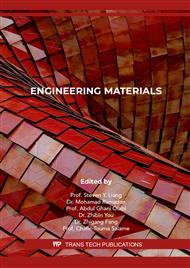[1]
A Heinz,A Haszler,C Keidel,S Moldenhauer,R Benedictus,W.S Miller. Recent development in aluminium alloys for aerospace applications[J]. Materials Science & Engineering A, 2000, 280 (1): 1995-2002.
DOI: 10.1016/s0921-5093(99)00674-7
Google Scholar
[2]
Zhang Hongxin, Jiang Yong, Zhang Tiezhu, etc. Current status and development of aluminum alloy die casting technology [J]. Foundry, 2007, 156(12): 1247-1250.
Google Scholar
[3]
Chen Furong, Li Guowei. Research status of 7075 aluminum alloy [J]. Machinery Manufacturing Abstracts (Welding Volume), 2019(01):1-7.
Google Scholar
[4]
Keong, Sha. Crystallisation and Phase Transformation Behaviour of Electroless Nickel-Phosphorus Deposits and Their Engineering Properties[J]. Surface Engineering, 2002, 18(5)112-119.
DOI: 10.1179/026708402225010010
Google Scholar
[5]
Liu Jizhao, Liu Wei, Yuan Haodeng, et al. The effect of solution aging treatment on the mechanical properties and microstructure of extruded 6082 aluminum alloy[J]. Heat Treatment of Metals, 2021, 46(6): 82-87.
Google Scholar
[6]
Z.H. Feng, Z.G. Zhang C.Q. Xia,R. Study of microstructure evolution and strengthening mechanisms in novel ZrBeAl alloys [J]. Journal of Alloys and Compounds,2016,689, 48-55.
DOI: 10.1016/j.jallcom.2016.07.310
Google Scholar
[7]
Zhang Shuo, Chen Yuanjun, Yuan Chao. ZL101A aluminum alloy casting-heat treatment integrated process[J]. Foundry, 2019, 68(05): 501-507.
Google Scholar
[8]
Fan Wenjing. Optimization and research on heat treatment process of ZL101A aluminum alloy wheels[D]. Hebei Agricultural University, (2010).
Google Scholar
[9]
Nie Tie'an, Peng Jihua, Tang Xiaolong. Research on the heat treatment process of ZL101A aluminum alloy[J]. Nonferrous Metal Processing, 2013, 42(05): 55-57.
Google Scholar
[10]
Wang Kuangfei. The effect of melt holding time on grain refinement of ZL101A alloy[J]. Foundry, 2015, 64(08): 780-784.
Google Scholar
[11]
Liu Juanjuan. The effect of aging process on the structure and mechanical properties of ZL101A alloy[J]. China New Technology and New Products, 2016(10): 48-49.
Google Scholar
[12]
Ma Guanghui, Li Runxia, Duan Lin. The effect of casting defects on the fracture behavior of ZL101 alloy[J]. Casting, 2018, 67(02): 162-166.
Google Scholar
[13]
Reza Vatankhah Barenji.Effect of reinforcement amount, mold temperature, superheat, and mold thickness on fluidity of in-situ Al-Mg_2Si composites[J].China Foundry,2018,15(01):66-74.
DOI: 10.1007/s41230-018-7095-5
Google Scholar
[14]
Zhou Yanjun, Song Kexing, Zhang Yanmin, etc. Study on the technology and properties of ZL101A alloy prepared by vacuum melting and casting[J]. Foundry, 2011, 60(12): 1167-1170.
Google Scholar


